September
2012
Bell-Boeing
MV22 Osprey
Hawker
Hunter FGA.9
M1939
61-K 37mm AA Mounting
|
September
2012 |
||
![]()
![]() Selected
WW2 70th Anniversaries this month:
Selected
WW2 70th Anniversaries this month:
Between 2009 and 2015, I will be pursuing a general modelling theme that marks selected 70th Anniversaries from WW2.
September 1942 - WW2 has truly reached its zenith and the bloody Battle of Stalingrad begins in earnest. By 3 Sept, German troops have control of the suburbs; Soviet reinforcements and supplies can only reach the city by crossing the river Volga, under constant attack by German artillery and aircraft. Savage and relentless house to house fighting, accompanied by artillery bombardments and constant air attacks reduce the city to rubble, but despite horrendous casualties and destruction the Soviet population and the Red Army remain firm; they will endure nearly 6 months more under seige before they acheive victory over General Paulus' Wehrmacht 6th Army.
7 Sep - The Battle of Milne Bay Allied Forces, led by Australian Militia and the 2nd Australian Imperial Force and with comprehensive air superiority, defeat a Battalion level amphibious assault by Japanese forces on the Allied Airfields at Milne Bay in New Guinea. This is the first Japanese defeat on land of WW2.
11 Sep - Stalin appoints Marshal Andrey Yeryomenko and Commisar (later President) Nikita Krushchev to lead the defence of Stalingrad. The 62nd Rifle Army, under General Vasily Chuikov, is established and tasked "to defend the city or die in the attempt".
5 Sep - The Battle of Alam el Halfa ends - Rommel's offensive has failed and his force withdraws in disarray, harried mercilessly by the aircraft of the Desert Air Force. General Montgomery's refusal to exploit the situation surprises Rommel, but it allows the Commonwealth 8th Army to preserve its strength in anticipation of the forthcoming 2nd battle of El Alamein.
Axis forces lay over 1/2 million land mines in defensive works across the Libyan front, but 500 lightweight Mine Detectors, designed in Scotland in 1941 by exiled Polish engineer and signals officer Lt. Józef Kosacki, are issued to the 8th Army for the first time, allowing them to sweep minefields ahead of Monty's tanks at a far greater speed than before.
Throughout the month, Allied forces conduct sea and air raids on North African ports, targetting Rommel's supply chain, with submarines and aircraft from Malta intercepting supply ships and tankers. Panzer Armee Afrika's logistic situation is now critical, with fuel in particularly short supply.
23 Sept - Rommel is taken ill and returns to Germany for treatment.
29 Sept - US volunteer -manned Eagle Squadrons of the RAF are transferred to the USAAF to form the US 4th Fighter Group.
US Marine Corps, 2012
ESCI 1/72, with extensive modifications.
After a long and very painful development, the radical MV-22 Osprey is now in widespread service with the USMC and USAF Special Ops Command. Still marred by controversy and scandal over its unclear safety record (there have been several crashes this year alone), alleged battle vulnerability, premature engine wear and fraudulent maintenance and incident recording at USMC bases, the Osprey is a fascinating design, half helicopter, half conventional plane, that is intended to allow the USMC to transit form amphibious ships to operating areas ashore at very high speed.
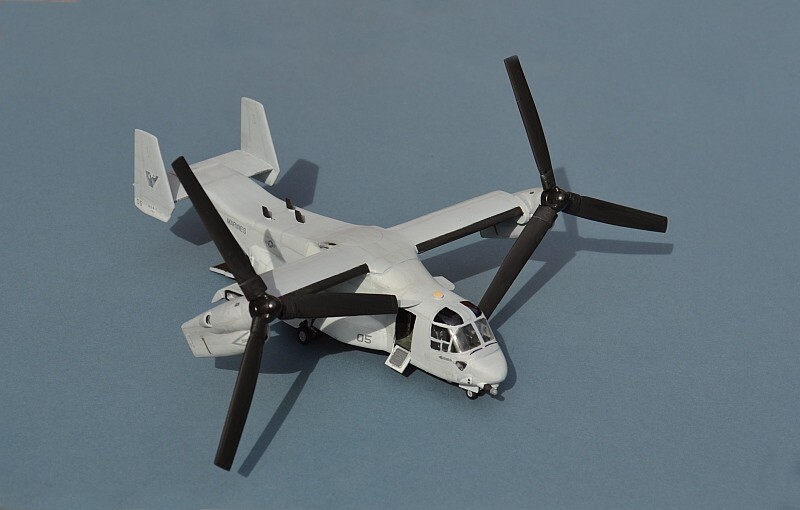
Plans to arm the aircraft and use it in other roles seem to have been put on hold for now, mainly due to budget constraints, but Bell Boeing continue to market it aggressively to potential overseas buyers.
Two Ospreys attended this year's RIAT and Farnborough airshows, putting on an impressive display of the aircraft's unique capabilities.
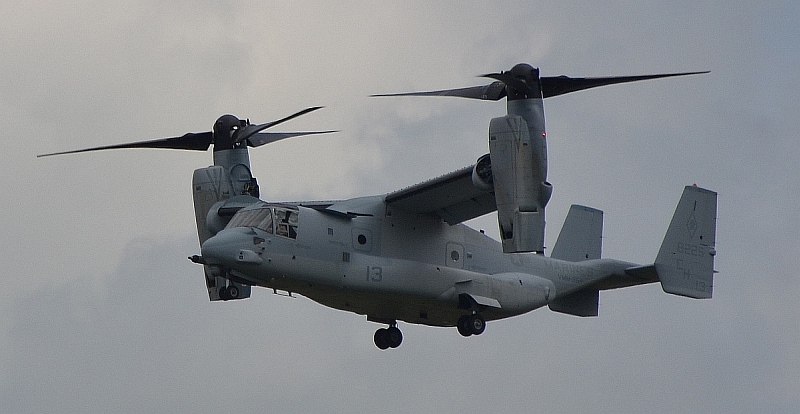
The real thing - an Osprey at RAF Fairford RIAT 2012 Airshow
ESCI were always very keen to get kits of new aircraft types out on the market early, often basing them on early protypes, concept models or demonstrators. Their 1/72 Osprey kit sits firmly in that category; available in at least 6 different versions, it lacks many of the refinements seen on current operational aircraf, but still conveys the unique features of this fascinating aircraft.

The ESCI kit box - there are at least 6 different versions of this kit, covering many proposed roles
Italeri have reissued this kit more recently, although I haven't seen one for a few years now.

The real thing - an Osprey at RAF Fairford RIAT 2012 Airshow
I spent some time poring over the static aircraft at Fairford with this build in mind; where feasible I have modfied the kit to represent the aircraft as seen, particularly by lowering the wing flaps, since it is seldom seen on the ground or in the hover without them in this state.

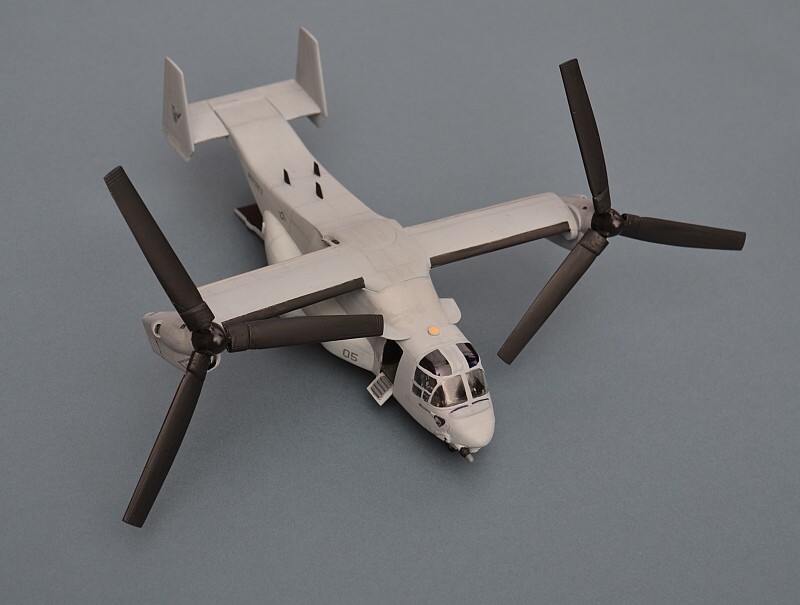
The kit comes in a large tray box, with mouldings in a nice silver-grey plastic. Detail is engraved, and the general fit is not brilliant, but OK.

As well as the flaps, external changes to the base kit included filling the spare "porthole" windows, modifying the landing gear doors, adding the "elephants ears" intakes on the engine nacelles, more representative ESM and GPS antennae and the LERX style vanes above the cabin roof.

Internally, to allow me to leave the ramp lowered, I added some representative detail, including cabin side ribs, electronics boxes and a liferaft.

Decals were a problem, since the kit set are a long way from current aircraft - I could only find one after market set for an operational machine, which was sold out, so I reverted to the trusty spares box and a few from the kit's own set. These were all coloured black, so I applied a quick filter coat of thinned grey paint to model to make them a tad more realistic. Panel lines received a thin oily wash, and the entire model was then coated in matt varnish.

And the finished article - pleasingly different, its not particularly accurate but conveys the general idea!




More US Navy & Marines Aircraft on my Friends & Allies pages
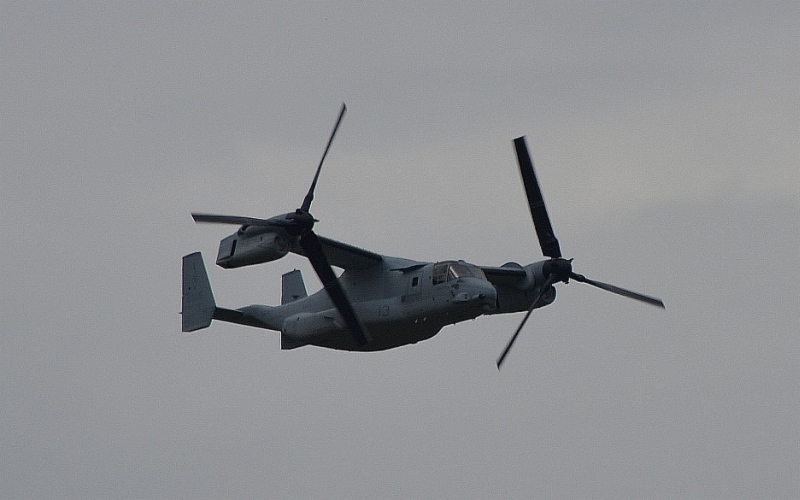
The real thing - an Osprey at RAF Fairford RIAT 2012 Airshow
58 Sqn, RAF Wittering , 1974
Airfix 1/72, with Matchbox decals..
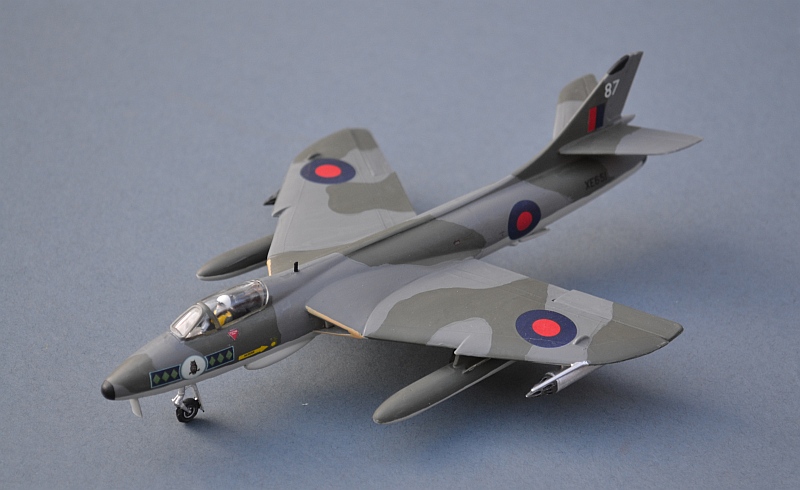
The Hunter has to be one of the most attractive jet fighters ever built. Long, thin and sleek, it combined an advanced engine with excellent aerodynamic design, to give a well behaved and versatile aircraft. Unfortunately, the long gestation period needed to get the design right meant that it quickly became obsolete as a fighter and was moved to the FGA role instead, with additional fuel and pylons for ground attack weapons. 58 Sqn operated Hunters from 1974 to 1976, training pilots in anticipation of the arrival of the new SEPECAT Jaguar aircraft.

Although all of the RAF's Hunters have long gone, the Hunter still continues in service around the world, with the Lebanese Air Force reinstating its very small Hunter Fleet to operational service in 2010. During the 1970s, the RN acquired a number of surplus RAF Hunters and continued to use them in the training and Fleet Requirements role until the early 1990s.
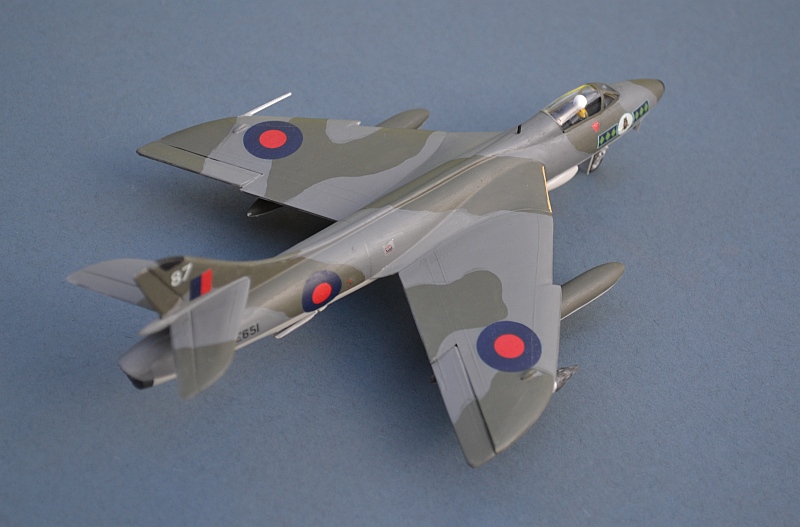
Although I have a couple of the newer Revell Hunters in the stash, this old Airfix one was sitting unloved in a crumpled bag, so I took pity on it and went for a quick fun build. The Airfix FGA.9 Hunter wasn't a bad kit for its time, although the recent Revell issues have far eclipsed it. However, it remains ideal for a quick build. I don't find the supplied decals particularly inspiring (although in my issue they are well printed and comprehensive), so instead I have used a spare set from a Matchbox kit for the short-lived 58 Sqn Hunter reincarnation from 1974-76, training ground attack pilots for the imminent arrival of the new SEPECAT Jaguar aircraft.

The kit is really quite crude compared with more modern offerings, but an easy build. There were quite a few sink marks in places (most of which I filled with Tippex), the rudder was missing (a new plastic card one was made up) and the nose had a nasty crack where one half of the fuselage had been twisted. I briefly considered straightening the wonky wing dog-teeth (they should be parallel with the fuselage), but I decided it really wasn't worth the hassle to do so.

Otherwise, its a good solid old-fashioned Airfix kit, fun to build and looks the part when completed!
More RAF Aircraft on my Friends & Allies pages
More Hunters (single and twin seat) on my RN Jets pages
|
Zvezda 1/72. The 61-k 37mm AA gun was very similar to the Swedish Bofors 40mm weapon and was widely deployed during WW2 by Red Army units on the Eastern Front, including those defending Stalingrad in 1942. Over 20,000 were built before production ended in 1945, with many more subsequently produced by the Chinese as the Type 55 gun. Many of these weapons remain in use around the world today, although their effectiveness against modern aircraft and weapons is very doubtful. Soviet 37 mm 61-K guns are credited with shooting down 14,657 Axis planes during WW2, at an average of 905 rounds fired per aircraft!
|
|
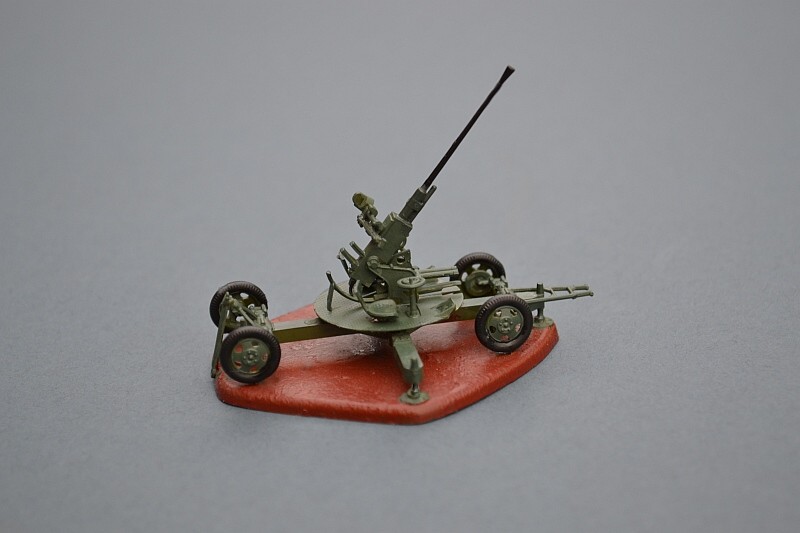
Zvezda produce some interesting kits; this one is part of a wide range in varying scales aimed mainly at the Wargamer. The kits are very cheap (at least in the UK) and despite being "snap together" products they have some very nice and delicate detail. The plastic is very soft and slightly oily, but it responds well to normal polystyrene solvent glue.
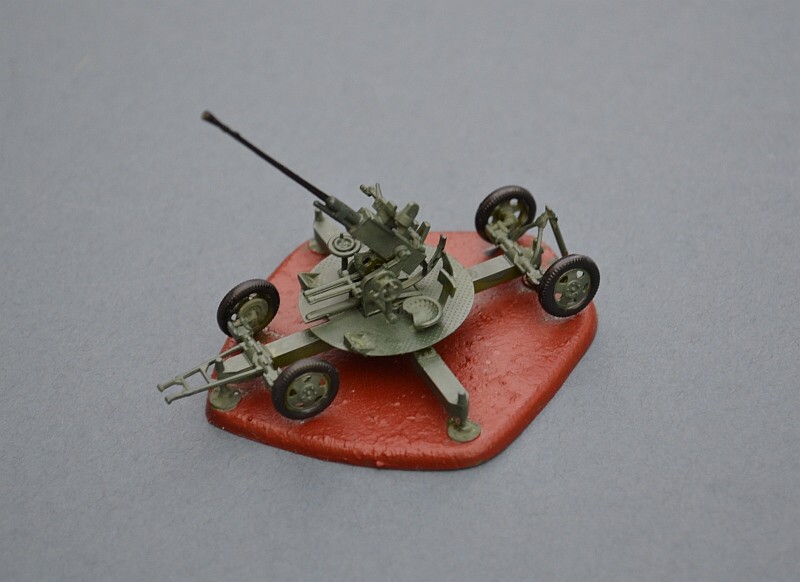
The kit comes with a well detailed Soviet crew of two (aimer and layer), with optional parts to build the mounting manned or unmanned (as you can see, I chose the latter!).

More Soviet & Allied AFVs on my Dark Side pages
Link
to previous month Link
to Next Month
www.gengriz.co.uk